Free shipping for all orders over 30 euros!
-
Shop
- Insights
-
About ROMBO
- Dealers
- Guitar Pick finder
- Gift Card
+Categories
- accessories
- bass
- bass pick
- bass picks
- bass plectrum
- bass plectrums
- beginner
- bright tone
- chose guitar pick
- chose guitar picks
- chose plectrum
- chose plectrums
- CrystalBright
- Diamond
- Diamond pick
- discipline and guitar
- DIY generation
- durability pick
- durable pick
- eco
- ecoblack
- find guitar pick
- find plectrum
- fingers vs picks
- grip
- grip guitar pick
- guitar accessories
- guitar advantages
- guitar benefits
- guitar career
- guitar health
- guitar injury
- guitar learn
- guitar lesions
- guitar lesson
- guitar method
- guitar noise
- Guitar noise plectrum
- guitar pain
- guitar pick
- guitar pick beginner
- guitar pick bevel
- guitar pick buy
- Guitar pick diamond
- guitar pick durability
- guitar pick durable
- guitar pick eco
- guitar pick features
- guitar pick grip
- guitar pick material
- Guitar Pick Noise
- Guitar Pick online
- guitar pick recycled
- guitar pick recycled material
- guitar pick special features
- guitar pick textures
- guitar pick thickness
- guitar pick variable thickness
- guitar picks
- guitar tone
- guitar warm-up
- guitarpick
- guitarpicks
- hold a guitar pick
- hold guitar pick
- hold guitar picks
- hold pick
- hold plectrum
- hold plectrums
- how to
- how to chose your guitar picks
- jazziii
- learn guitar
- lose guitar pick
- material
- materials
- mental health and guitar
- motivation and guitar
- music
- not to lose guitar pick
- Online guitar
- online guitar pick
- online guitar pick buy
- pick
- pick durability
- pick material
- pick noise
- Picks
- picks vs. fingers
- play bass fingers
- play bass picks
- play bass with fingers
- play bass with pick
- play bass with picks
- play bass with plectrum
- play guitar faster
- plectrum
- plectrum attributes
- plectrum beginner
- plectrum bevel
- plectrum characteristics
- plectrum features
- plectrum grip
- plectrum material
- plectrum noise
- plectrum recycled
- plectrum shape
- plectrum variable thickness
- plectrums
- Plek
- pua
- recycled
- recycled guita pick material
- recycled guitar picks
- recycled picks
- recycled plectrum
- Rombo Diamond
- rombopicks
- tendonitis guitar
- the guitar pick
- tone
- variable thickness
- warm tone
- warm-up guitar

Understanding Guitar Pick Grip: Essentials
The grip of a guitar pick is one of the most controversial topics when it comes to guitars.
Different materials or shapes of guitar picks make this topic as interesting as confusing to many guitar players.
Everyone is different and everyone plays differently. However, we (guitarists) have the same goal in this area: have a decent guitar pick grip and play as comfortably as possible.

1. What is Guitar Pick Grip?
Grip is defined as “a firm strong hold”.
The grip of a guitar pick should be good enough to avoid the slipping of the pick, the turning of the pick, or (worst case!) the dropping of the pick. In addition, it should be able to give you enough flexibility and freedom to change the position of the pick when needed.
The grip is mainly caused by the material and the texture of the surface. Nevertheless, there are other aspects like overall size or 3D geometries that can substantially increase how firmly a guitar pick can be held.

2. Advantages of Guitar Picks with high Grip
Guitar picks with a high grip can help to keep your pick from slipping. These guitar picks “stick” to your fingers even when you play aggressive guitar techniques.
They are also known for providing a feeling of secure hold and control. Your hand will need less tension to hold the pick and this will help to relax your muscles.
We have already discussed how important it is to have relaxed muscles when practicing guitar in our article “7 easy warm ups every guitar player should know”.

The biggest advantage is their usage in live performances, where control and security is essential to play correctly every chord. However, they can still drop and get (instantly) lost. Therefore we suggest having a couple of extra picks with quick access somewhere on the stage or to use a Guitar Pick Holder.
3. Disadvantages of Guitar Picks with high Grip
Although guitar picks with high grip feel very secure, this feature often comes with some disadvantages. The aggressive grip surface can feel uncomfortable or even damage your skin. This is a common problem for professional guitarists training over 2 hours a day.
The high grip sticks to the fingers and this eliminates some of the freedom you have when moving your pick on purpose, for example when you change its position to execute pick slides or harmonic pinches.
4. Types of Grip Textures on Guitar Picks
Depending on the type of guitar you play, your music style and techniques, or how sweaty your hands are when you play the guitar, you will need a different type of grip texture.
These are the most common grip textures on guitar picks:

Guitar Picks with Sandpaper Grip:
Maximum grip. Very aggressive texture. Can be uncomfortable for long playing sessions.
Guitar Picks with raised Geometries or Logos:
High grip. Aggressive texture. Can feel uncomfortable for long playing sessions.
Guitar Picks with Micronodules Texture:
Medium grip. Comfortable texture and adequate for long playing sessions.
More information about this grip texture can be found here.
Grip Holes or deepened Geometries:
Medium grip. Sometimes uncomfortable when holding the pick very tight.
Homemade Guitar Pick Grip:
Some players use tape or make scratches on the pick surface to create a custom experience.
5. Less common Ways to increase Grip on Guitar Picks
As mentioned before, not only material and textures can create grip on guitar picks. There are two factors that are usually unknown and can be very helpful to increase the grip.
Using Guitar Picks with 3D Geometries on the Hold Area:
3D geometries are an underestimated way to increase grip on guitar picks. The concave and convex surfaces will create a very defined position of the guitar pick and avoid the turning of the pick without the drawbacks of aggressive textures.
In addition, correctly tilted surfaces will use your fingers as support or pivots when moving the pick on purpose.
At Rombo, we believe this is the future of guitar picks and we are increasing our efforts in this area.
One very visible example of this is Rombo Crisp.

Using a larger Guitar Pick:
The shape and size of a guitar pick are essential to increase the grip. The larger the surface, the more contact it will have with your fingers, and therefore the more friction it will create.
The best example for this are bass players that use picks. The strings of the bass are very thick and with every impact, the pick must be held very firmly. Most bass players use big sized triangle picks or teardrop picks with enough surface on the body.
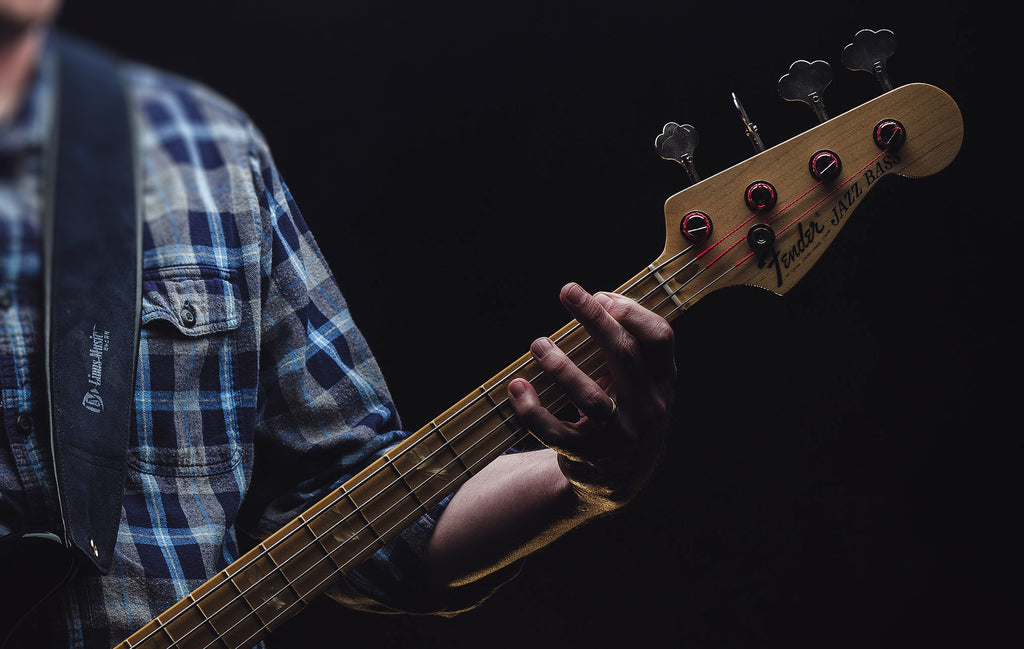
Holding your Guitar Pick right:
This is an external factor and not intrinsically dependent on the guitar pick. However, I decided to include it because of the number of players having trouble with this issue and not being aware of it.

If you feel you cannot hold the guitar pick firmly and some techniques make the pick slip or drop, you should question how you hold a guitar pick before you question the grip provided by the pick.
For these people, we created an article called “How to hold a guitar pick”, which can be found here.
6. Guitar pick Grip at Rombo
The absolute guitar pick grip of our picks is determined by four factors:
- Material
- Micronodules grip textures
- 3D geometries
- Variable thickness
The combination of these factors creates a medium-high grip, which is still comfortable enough for long playing sessions and adequate for live performances.

When developing the grip, our focus was to create a type of grip which allows the player to keep enough flexibility and freedom, as well as providing a high feeling of security and control.
With the material, we made no compromises and chose a very improved version of nylon manufactured in Italy. We have discussed its properties here.
7. The adequate Guitar Pick Grip for you
It is up to you to find a balance between comfort and grip. Some players prefer non-sticky guitar picks, others need the maximum grip available.
Depending on your playing style, your hours of practice, and the environment (solo, studio, live, ...), you might need different guitar pick grips for different occasions.

Personally, I put comfort at the top of my priorities when it comes to guitar playing. Once I get used to a guitar pick, the grip is a secondary aspect to take into account. If I choose a comfortable holding I can put my attention on other aspects like tone or attack.
8. Conclusion and last Thoughts
There are many different levels of guitar pick grip depending on the material, the textures, the size, and other secondary aspects.
The greatest guitar players use different picks for different occasions or instruments, and we recommend having at least 3 favorite guitar picks to vary things like tone, attack, grip or flexibility, and become a more versatile guitar player with the ability to adapt yourself to different environments.
Choosing the right guitar pick grip is a journey every guitar player will experience. I hope you enjoy the journey and try lots of different and interesting types of guitar picks!


Guitar Pick for Beginners
Guitar picks are one of the most useful accessories for beginners, who have just started to play the guitar or bass.
Having a guitar pick won’t make you a professional guitar player faster, but will enhance the playability of your guitar.
With the right plectrums, you can easily learn new techniques and shape your skills.

The amount of guitar pick brands available on the market today is huge. This can be overwhelming if you are a beginner guitarist, and choosing the right guitar pick can be a tough process if you start in the wrong place.
But first of all: Who is considered a beginner guitar player?
Who is Considered A Beginner Guitar Player?
A beginner guitar player could be someone who just started playing last week, or, someone who has been practicing guitar for 2 months.
It is very difficult to define a line between the beginner and intermediate stages of guitar playing. Especially when you have learned to play the guitar yourself.

In general, to be considered an intermediate player, you should know and master the following areas:
- Change smoothly between fundamental open chords.
- Know power chords and be able to move around then cleanly.
- Know the difference between major and minor basic chord shapes and sounds by hearing.
- Know the note positions on the fretboard for the low E and A strings.
- Having mastered a significant amount of strumming patterns.
- You are able to practice using a metronome, and are aware of your comfort tempo for every technique.
- Have a basic understanding of music theory for musical keys and chords.
- Play through several complete songs smoothly.
- You’ll need to feel familiar with the basic lead techniques of picking, bending, and sliding,...
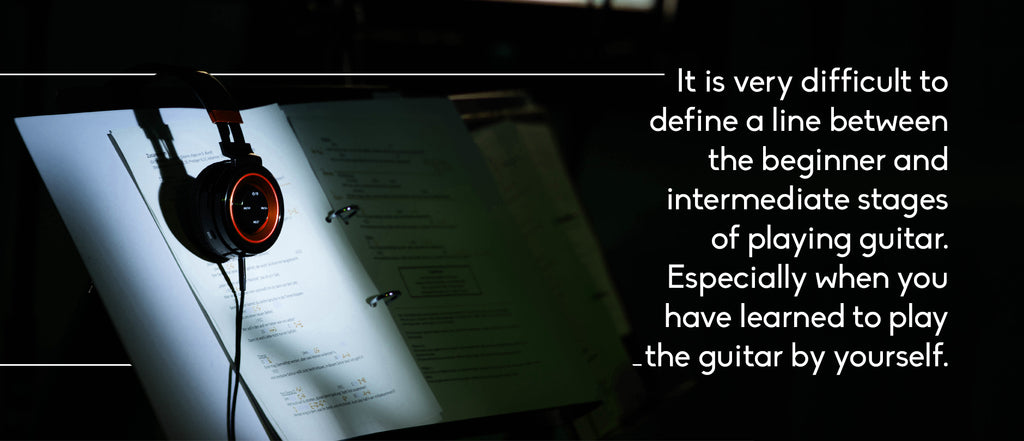
Why Use Guitar Picks?
Guitar Picks have different advantages when comparing them with fingers.
Guitar picks help increase your playing speed, produce a louder, brighter sound than fingers, and can be shaped to achieve better results when using different techniques like strumming or palm mute.

In general, plectrum techniques are easier to master than classical fingerstyle, or hybrid. It is easier to play fast picked notes.
As a beginner, this is very motivating, since your process of learning will be accelerated.
Guitar Picks - Quick Guide:
At the very beginning of your guitar learning process, your feeling of sound and feedback provided by a guitar pick as not yet developed.
Therefore, you should consider only these two attributes of a guitar pick:
- Guitar Pick Thickness
- Guitar Pick Shape.
Simplifying the “science” of a guitar pick will help you make a fast choice without spending too much time and stress.
After your first couple of months playing guitar, you will develop new skills, which will allow you to introduce more complex factors to your final decision of which pick to buy, guitar pick material, guitar pick size, and other special features.
If you feel secure enough to understand these additional features of a plectrum, go to our guide: How to choose the right guitar pick, which you can find HERE.
For the thickness and the shape, here is where you should begin:
0,75 mm Guitar Picks: The Best Choice for Beginner Guitar Players
Light guitar picks with less than 0,6 mm are considered beginners’ guitar picks.
The reason for this, is that most beginner guitar players first learn strumming techniques, which can usually be played better with thinner plectrums.
However, medium guitar picks with 0,75 mm thickness are the best place to start.

Plectrums with medium thickness are the most versatile in terms of tone, and can be used for rhythm and lead guitar.
If you are having fun with strumming exercises, medium thickness will perform well. If you need to practice some lead guitar techniques, it will work as well.
Depending on the kind of guitarist you want to become, you may consider moving to a higher or lower thickness range afterward.

Rombo Origami is a good example of a medium thickness guitar pick.
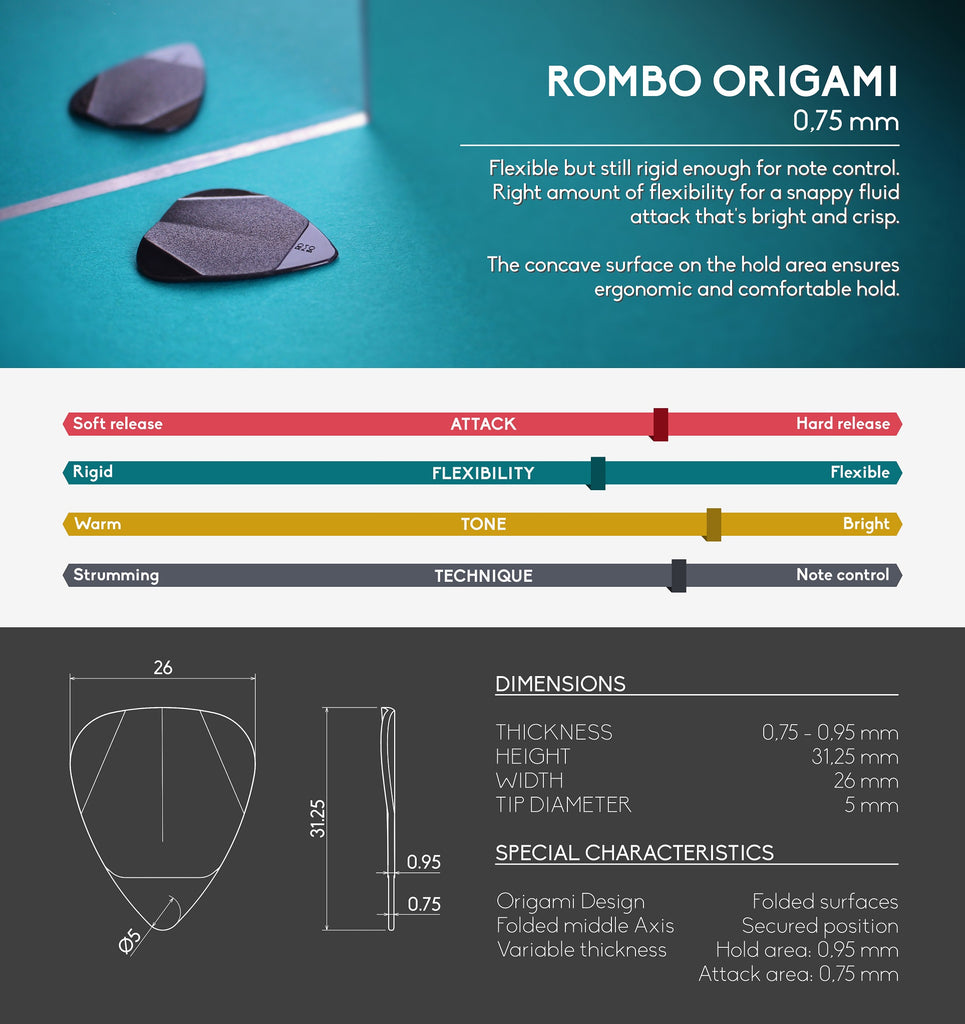
Teardrop Shape and Standard Shape Guitar Picks: The Best Choice for Beginner Guitar Players
Teardrop shape and standard shape guitar picks are simply the most common shapes for plectrums, and globally famous by every single guitar player.
You cannot go wrong if you use one of these shapes for your first guitar pick.
Both picks have enough surface for a solid grip, and the tip has mostly a medium radius, and often even a light bevel edge for smoother playing.
When is it time to change the guitar pick?
I am not talking about wear and tear. For this, we already published the article “Guitar Pick Durability”
What I really mean is, when is it time to question the guitar pick model you are using and use a different thickness or a different material?
Avoid sticking with a single guitar pick model for the rest of your life.
Using different guitar picks will give you the possibility to increase your tonality ranges, develop a more accurate feeling for different guitar techniques, and be more aware of your preferences when it comes to guitar gear.
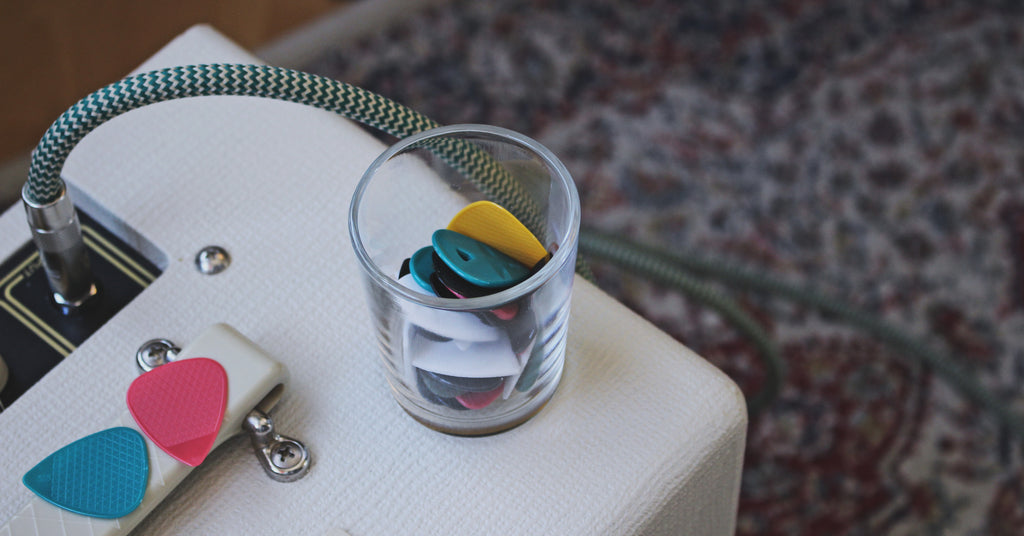
Therefore, the answer is: always! I cannot recommend enough, the benefit of testing as many different plectrums as possible, and then decide which ones are your favorites.
I used the plural noun “favorites”, because you should find at least 3 of your top guitar picks.

As you develop your skills as a guitarist, you will notice that some guitar pick shapes, or guitar pick thicknesses, are more adequate for specific techniques.
Discover our variety pack HERE
In my case, I like medium picks for strumming, hard ponty guitar picks for practicing scales and loud music, and very rounded guitar picks for the days I just want to relax, use my reverb pedal, and create beautiful clean guitar melodies.
Conclusion: The Right Guitar Pick For Beginners
An important part of learning guitar, is knowing the gear you use: The amplifiers, the pickups, the different guitar strings, the guitar pedals, and also the guitar picks.
Don’t feel overwhelmed by the amount of guitar picks out there. It’s just a matter of preference, and you will have to spend some time trying new guitar picks, which can be fun and bring you some nice experiences.
You can start with a standard shaped guitar pick with 0,75 mm thickness. But, if you don’t feel comfortable with just one option, try a variety pack, containing some different guitar picks. Close your eyes, and chose the guitar pick that feels right to you.
Please leave a comment and tell us the thickness of the first guitar pick you had. Thanks!

Picks vs. Fingers for Playing Bass Guitar
You have probably heard this question many times: Should I use a pick or my fingers to play bass? You can find a huge amount of different answers on the Internet and still be confused.
My philosophy is, to never limit yourself. Both methods are valid and appropriate for the right musical context.
Picks vs. Fingers: The Eternal Debate
Whether using picks or using your fingers, each technique has its place and, ideally, you need to feel comfortable with either one you choose.
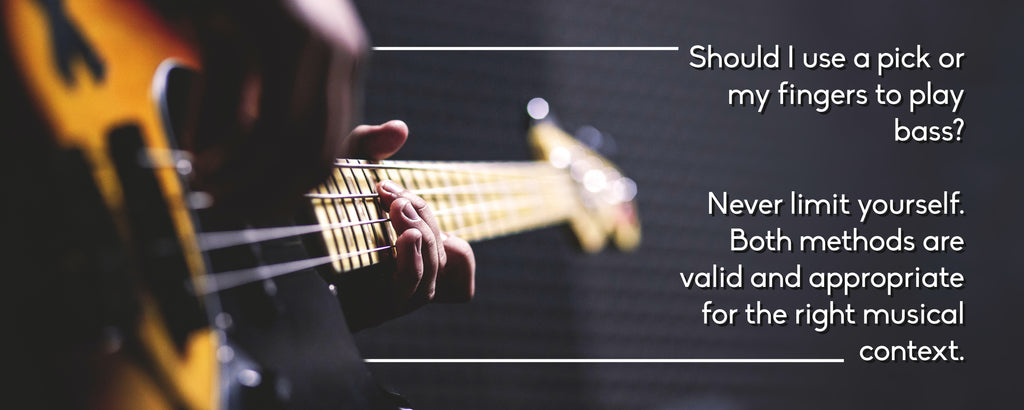
Is there a wrong way to play an instrument? Any method you use to get sound out of your instrument - fingers, pick, nails, palms of your hands, etc - can work, if the sound produced is the sound you are looking for. It is entirely a matter of personal preferences.
Therefore, this is an unimportant debate, if your plan is to be a versatile musician, and be able to understand the rich parts of every bass line, regardless of the method used to play them.
For me, it is difficult to understand how this debate has been one of the most controversial topics since the advent of modern music creation decades ago.
Why not keep an open mind and become comfortable with both methods? There is room for everything.
Using Fingers to Play Bass
Usually, bass players report having more control when using their fingers, giving them a richer tonal variety, and beefier tone. In Addition, the popular slap technique used by many bassists can be easily implemented, if you don’t hold any pick between your fingers.

A funny positive argument is, that you will never lose your bass pick if you don’t own one.
One of the drawbacks of this method is that it takes a little more work to learn. Nevertheless, if your goal is long-term learning, this should not be a technical obstacle.
Using Picks to Play Bass
The biggest advantage of using a pick for the bass guitar is obvious: Instant speed. You can develop speed more quickly and effortlessly.
If the bass lines you want to learn, belong to certain music styles that are speed intensive, a pick might make sense. You can develop the same speed as with your fingers, but it will take much more time.
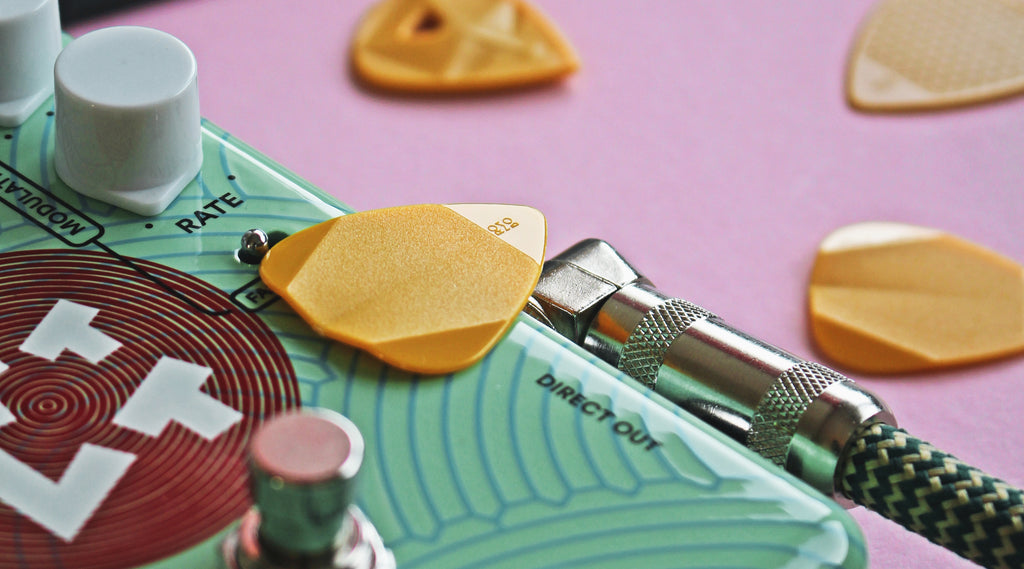
In addition, the tone can be easily changed by using a different guitar pick. This allows you to have different tones, and experiment a lot to find the right sounding bass guitar pick.
Every pick - for guitar, bass, or other instruments - has four different main parameters: Shape, material, thickness, and size. Combined together, they result in a very specific range of tone textures, attack soundwaves, and feedback. Therefore, choosing your guitar pick is one of the most difficult tasks. We have created a guide HERE, that will help you find your tone.
Pick Thickness for Bass Players
Bass players generally use thicker picks. The thickness improves the bass playing control, and the overall tone of the string.
The average pick thickness for bass players is 1.17 mm, while for guitar players is 0.89 mm. Remember, bass strings are much thicker than guitar strings. Therefore, a thinner plectrum will give you much less control in comparison to a thicker plectrum.
The size of the pick will also have a role in the creation of the tone.


Having said that, there are still many bassists who do prefer to use thinner bass picks, like for example Rombo Classic, or Rombo Origami.
If you have no idea where to start, take the average value and look for picks with a gauge of about 1.2 mm. This is a good place to get started. From there, you can go up and down and try other picks depending on your preferences. It might be a good idea to look for the bass picks your favorite players use, and try to understand why they do so.
Most Popular Pick Shapes for Bass:
The truth is, most classical shapes tend to have an excellent reception between the bass players.
The most popular shapes are the classical teadrop pick shape, the rounded teardrop pick shape, and the triangle pick shape.
In addition to shape, there are many other attributes that define a pick. HERE you can read about the 6 most underrated attributes of guitar and bass picks.
Teardrop
Teardrop is the most popular and known type of guitar and bass pick. Semi-sharp point for quick attacks, that maintain a wide range of possibilities, depending on the thickness and material used.
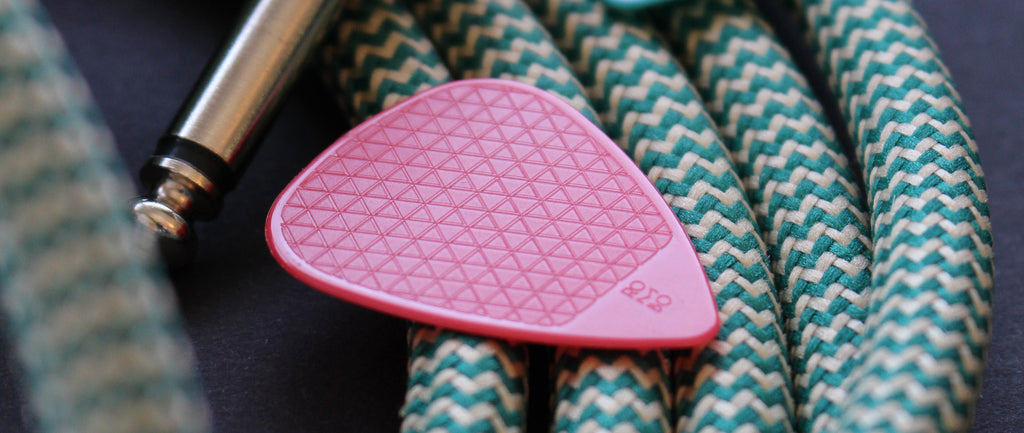
Rounded
Rounded picks provide a more warm sound and smooth attack. These are for the bass players looking for a way to play the bass strings with less force and attack. Sometimes they are totally free when a teardrop pick is completely worn down.
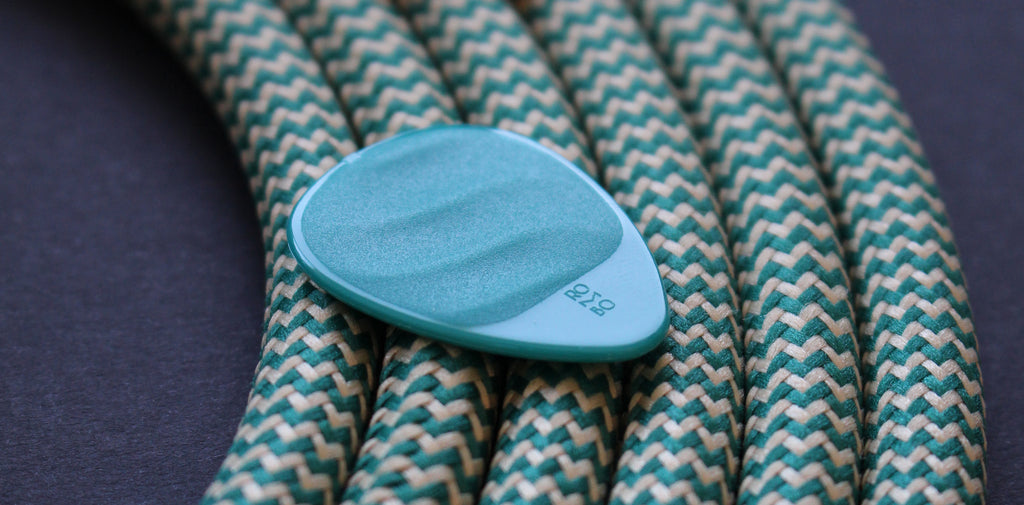
Triangle
A triangle pick is the most practical option because of the tri-sided feature. You can pluck your string with any of the three pointy tips this pick provides. A triange pick is recommended for those players who constantly break the tips of their picks.

Pick Materials for Bass Players:
When it comes to bass, we apply the same rules as with guitar picks.
After studying the physics of guitar picks, and all the material possibilities we have, we came to the following conclusions. The pick material should:
- feel nice to the touch and be comfortable, yet provide grip
- be able to create clear tones, without compromising the bass tones
- be very versatile: feel flexible when thin, and feel stiff when thick
- be durable
- look nice

You can read all about materials used at Rombo HERE.
You will also find a link with the information about Eco-Black - These picks made out of 100% recycled fibre waste, that we manufacture ourselves.
The durability of Bass Picks:
Because the strings are thicker, and bass players tend to play with more energy, the lifetime of your pick will be substantially reduced.
A way to reduce the wear and tear of picks for bass is:
- Using thicker picks
- Using harder materials
- Using picks with polished tip
- Using triangle picks (3 tips take longer to wear down).

Conclusion:
Playing bass with a pick is as valid as using your fingers, if this is the tone you are looking for.
Finding a pick you are comfortable with, is a difficult task, but testing lots of them and recording some of your bass lines can help you find a balance between the tone you want, and the feel and feedback you wish from the pick.
In picks, qualities like thickness, material, shape, and size play a pivotal role in tone, feedback, grip, pick noise, sustain, etc... Music is about staying dynamic and monotony kills dynamic. Therefore, the most logical step for you is to explore enough to understand as many aspects of the bass as possible.
This applies to guitar gear in general (including picks, strings, cables, etc...) and your practice habits, style preferences, and your own psychological bias/barriers.
Sometimes the best place to start is testing a Variety Pack

- Shop
- Dealers
- Legal Notice
- Terms of Service
- Refund Policy
- Shipping
- Privacy Policy
- Contact us
- Press
- FAQ
Sign up to get the latest on sales, new releases and more…
By signing up you agree to our privacy policy.
© 2024 ROMBO.
registered brand
Powered by Shopify

